You’ve reached your limit!
To continue enjoying Utility Week Innovate, brought to you in association with Utility Week Live or gain unlimited Utility Week site access choose the option that applies to you below:
Register to access Utility Week Innovate
- Get the latest insight on frontline business challenges
- Receive specialist sector newsletters to keep you informed
- Access our Utility Week Innovate content for free
- Join us in bringing collaborative innovation to life at Utility Week Live

Ben Aston, biodiversity specialist at Yorkshire Water, sheds light on the firm's joint investment in pollinator superhighways and their impact on managing its water catchments.
Yorkshire Water recently revealed that surveys are underway at six of its sites – Fewston, Swinsty, Thruscross, Embsay, Grimwith and Barden reservoirs – after they were slated to become part of a new pollinator superhighway.
This will see £30,000 jointly invested in the Bee Together project with Yorkshire Dales Millennium Trust (YDMT), which has already helped to deliver projects worth approximately £30 million.
The Bee Together project aims to create an unbroken, wildflower rich, stretch of wildlife through both rural and urban areas with the aim of improving biodiversity and reversing the decline of wild pollinators in the region.
Yasmina Gallagher, a technical specialist at Yorkshire Water, says that such conservation efforts often go hand-in-hand with the firm’s management of water catchments.
According to Forest Research – the research agency of the Forestry Commission – trees and woodland are effective at intercepting aerial drift of pesticides, as well as other pollutants, that would otherwise enter watercourses.
Water in rivers, lakes and estuaries reflects the quality of its immediate surroundings, with a higher standard helping reduce the cost and environmental impact from energy use and treating water, the agency adds.
“Our colleagues will be volunteering their time to carry out pollinator surveys, create action plans and deliver the habitat the bees require to thrive in our area,” Gallagher explains.
Need for healthy, functional ecosystems

The announcement of joint investment in the Bee Together project preceded the company sharing a series of stark images to illustrate the devastating effects of water shortages on its reservoirs and demonstrate how the region will be affected in the next 25 years if action is not taken.
As reported by Utility Week, the depiction of what its reservoirs could look like by 2045 followed a survey which showed that less than half its customers were concerned about shortages.
According to Ben Aston, biodiversity specialist at Yorkshire Water: “Part of our remit is to collect, treat and distribute a natural resource to our customers so we are aware of the need for healthy, functional ecosystems to allow us to do this in a sustainable manner.
“This project [Bee Together] is just one example, but we are delivering a large portfolio of activities such as river restoration schemes, fish passage, invasive species control, moorland restoration, farm environmental improvements etc., to ensure this continues.”
Protect and create pollinator habitat
According to figures from the Food and Agricultural Organisation of the United Nations, some 80 per cent of all flowering plants – including fruit, vegetables and crops that feed livestock – are pollinated by animals, mostly insects such as bees.
What’s more, according to the Woodland Trust, it has been estimated that it would cost UK farmers £1.8 billion per year to manually pollinate their crops, which just further emphasises the importance of bees.
However, the 2016 State of Nature report revealed that 60 per cent of bees and other pollinators are in decline.
“Bees continue to face a wide range of threats, from toxic pesticides to climate change, however the most significant reason for their decline is the loss of wildflower-rich habitats,” Bee Together officer Catherine Mercer explains.
“Projects such as this one are vital in reversing these declines, through engagement, education and practical conservation. Working with Yorkshire Water on their sites is a great opportunity to protect and create pollinator habitat as part of a wider network, making a real difference for pollinators locally.”
Potential expansion
 Aston adds that while the Bee Together project has been driven by the importance of increasing pollinator habitats to benefit native insects, it also encourages the firm’s customers, staff and volunteers engage with nature locally.
Aston adds that while the Bee Together project has been driven by the importance of increasing pollinator habitats to benefit native insects, it also encourages the firm’s customers, staff and volunteers engage with nature locally.
He also explains that Yorkshire Water’s move to six capitals accounting – covering natural, social, human, manufactured, intellectual and financial capital – and new land strategies helped identify the importance of delivering sustainable projects that strengthen the landscape in which they operate. “An approach from YDMT proved to be an ideal way of delivering this,” he says.
“As such, we are open to expanding the programme if the work continues to succeed and monitoring is showing a benefit to customers and the environment. Our role is just one player in a much larger landscape scale programme of conservation being delivered by a variety of groups across Yorkshire.”
According to Aston, the YDMT has also been able to train volunteers from Yorkshire Water in pollinator identification and management, and ensure that seed funding is used appropriately to help create new and lasting habitat.
“The engagement and social benefits are happening already,” he says. “Pollinator habitat creation will see a benefit next year and differences will continue to be monitored into the future.”

See this content brought to life at Utility Week Live, 17-18 May 2022 NEC Birmingham
Delivering smart water networks is one of the frontline challenges at the heart of Utility Week Live 2022’s live content programme.
View the challenges and be alerted for tickets to the industry’s most eagerly awaited reunion at utilityweeklive.co.uk.
Please login or Register to leave a comment.